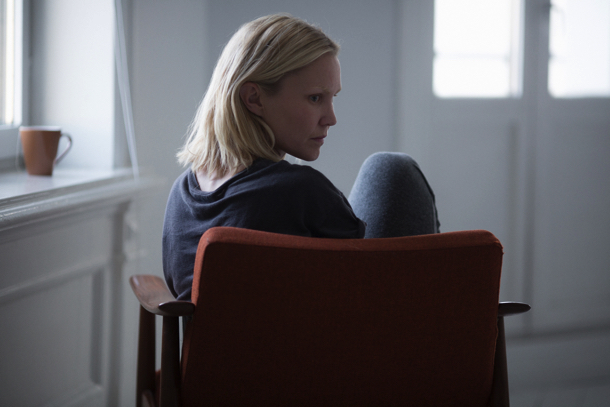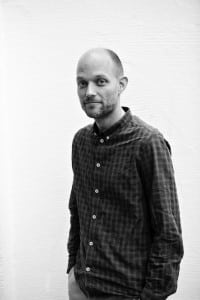
 Eskil Vogt is playing with the essence of cinema. That’s what the slim-looking Norwegian director tells me as we sit for a chat after the London Film Festival screening of his latest, BLIND, which has toured the world since its premiere at the Berlinale 2014. But Vogt also taps into the building-blocks of storytelling in his depiction of blind writer Ingrid, played superbly by Ellen Dorrit Petersen, who toys with our understanding of cinematic narrative as she narrates her own damaged relationship with her husband Morten (Henrik Rafaelsen) after recently losing her sight.
Eskil Vogt is playing with the essence of cinema. That’s what the slim-looking Norwegian director tells me as we sit for a chat after the London Film Festival screening of his latest, BLIND, which has toured the world since its premiere at the Berlinale 2014. But Vogt also taps into the building-blocks of storytelling in his depiction of blind writer Ingrid, played superbly by Ellen Dorrit Petersen, who toys with our understanding of cinematic narrative as she narrates her own damaged relationship with her husband Morten (Henrik Rafaelsen) after recently losing her sight.
EV: Blindness has a long relationship with stories. Just look at the Western canon’s earliest entrant, Homer, who’s frequently represented as blind. Perhaps without sight, fantasy and imagination can run wild. The way we imagine the origins of storytelling, around the fire surrounded by darkness with the flames flickering – you need the unknown around you for the story to work.
F: There’s something nightmarish in the way you presents blindness in the film – as if you were scared of going blind.
EV: It’s strange, people often ask me whether I’d rather be blind or deaf and immediately I say I’d rather be deaf. But when asked by a Norwegian radio station if I’d rather be deaf and lose a right arm, or be blind, I still admit, grudgingly: That’d be harder but I’d still let my right arm go.
F: Wouldn’t you miss, say, music?
EV: You’d get isolated, but I can’t imagine myself without visual intuition. Actually what people are afraid of is change. A deaf person might say ‘How could I not see the face of my lover?’ But I’ve met blind people who’ve said they couldn’t imagine never hearing the sound of their child.
F: What do you think of audio-described performances for the visually impaired?
EV: I was very surprised that blind people like to go to the cinema. Some of them listen to the description and some of them not – it’s too much dialogue, but also they want to experience the original feeling in a way.
F: Like, I suppose, their everyday experience?
EV: They miss some important visual cues, but they prefer that to having the movie descriped to them! We managed to be the first film in Norway to have the film audio-described with smartphones with an app. You download the additional soundtrack and there’s a sound at the beginning of the film – which we can’t hear – that syncs with the smartphone and they have this additional audio description.
F: Could we see that in the UK?
EV: It’d be great if they did this abroad, but they’d have to do the dialogue. It’s more expensive!
F: But you didn’t make the film for blind people.
EV: No, it’s a very visual film. But when we did screenings, blind people had really experienced the film. They ‘saw’ visual details in the film that I couldn’t for the life of me explain how they picked them up. I’m a die-hard film fan, a defender of celluloid and projection. I hate when people watch my movie on computer screen or – god forbid – a smartphone. But when a blind person can understand without seeing, I am less afraid of that technology.
F: On some level, BLIND plays out as an offbeat relationship drama, but how you use blindness creates all sorts of subversive narrative connotations – where did the idea originate?
EV: In the beginning, I thought blindness could be kind of interesting, but I didn’t know why. My first hunch was a blank screen with sound – it would be a cheap movie to make, but wouldn’t be seen much! And more than that, it isn’t true to the experience of blindness. BLIND is about someone who has lost her sight, so she has this visual imagination. Blindness is about these mental images.
F: Blindness can be difficult for sighted people to portray – I’m thinking Audrey Hepburn in Waiting for Dark – how was directing Ellen Petersen?
EV: What was the key to it was the body language. Because Ingrid moves around quite freely, but she has that little inhibition, guarding her body all the time. She tenses up a little, having this extra guesture to check if there’s something, for instance, is on the table before she puts her glass down. What made that sound? Is somebody watching me? Always that gesture just made it believable.
F: And there is somebody watching her – us.
EV: Yeah, I suddenly realised every scene I was filming was about watching and being watched. Even the sexuality of a blind person – still wanting to be desired, wanting to be seen. And that you could see in other films, in very visual films – in Hitchcock. I got the impression I was working with the basic stuff of cinema.
F: I remember Fellini saying that cinema used the language of dreams – with Ingrid’s imagination, were you thinking along those lines?
EV: Definitely. Cinema is also something of reality, of documentary. It’s true, it’s one of the strengths of cinema that you capture the actor at that age, that moment. That’s inarguably cinema. But to say it’s realism, that’s not true. You leave out a lot of stuff if you present this angle or that angle of their face. Reality is without any cuts – but that’s not how you perceive reality. Something of the essence of film is when you put two images next to each other, and something happens. Something more than just two images, something going from ‘this’ moment to ‘that’ moment. That’s when cinema really happens sometimes. That’s less reality and closer to our thoughts and to our dreams. Even though I was so obsessed with blindness, researching, getting to know blind people, I was more interested in how do we think about stuff, perceive things, change our ideas when we get more information. Anxieties inform what we see, so what we see is tainted by what we expect and fear is going to happen. How do we portray it on film? I think my film is about that.
F: There’s a central scene in the film in the aftermath of Anders Breivik’s attacks, were you looking to explore anxieties and feelings of Norway as a society?
EV: A young girl said that in Norway. ‘If one man can do that with hatred, imagine what we can all do with love’, a very beautiful statement, but a very naïve statement, because it unfortunately much easier to have an impact doing evil.
That’s the case with Ingrid and Morten’s broken marriage – their anxieties are stronger than their love. Yes, it’s easier to mess something up than keep something together. It’s harder to have an impact being a loving caring person. But love, some people don’t have that. The character of Einar (Marius Kolbenstvedt) sits around watching porn but is re-engaged into society as Breivik’s attacks. It was my entry point really, it represented that person’s loneliness. A week after the attacks I was supposed to be by my desk and writing, but I had the feeling like many in Norway of, ‘How can I continue with this stupid story’, with this woman, and some jokes and some pornography in it? I felt so futile. I never thought it would be part of the film, but it just felt right.
F: Did you think of Norwegisn people as blind, not expecting these kinds of things to happen to them?
EV: We’re very self-contained people. When the explosion happened in Oslo, everyone thought, ‘Oh we’ve got Muslim terrorists as well.’ And it turned out it was one of our own. And we could have used that to go much deeper in introspection. Instead we said ‘we’re all in this together’ but we were just forgiving ourselves. It was a missed opportunity. Instead we won the world championship in grief that year. Ed Frankl
BLIND IS ON GENERAL RELEASE FROM 27 MARCH 2015